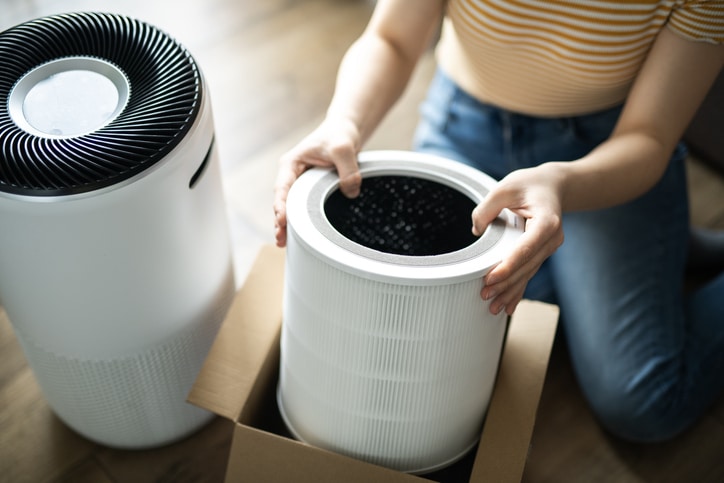As the seasons change in Western Pennsylvania, it’s time to enjoy the crisp air, colorful leaves, and cozy evenings that fall brings. However, for allergy sufferers, this transition can also mean an increase in symptoms.
While pollen is often the culprit in spring, the shift indoors during fall exposes people to a different set of triggers. Dust mites, mold spores, pet dander, and lingering pollen can all impact indoor air quality and make allergy or asthma symptoms worse.
 At Allergy & Clinical Immunology Associates, we know how important it is for local families to feel comfortable in their own homes. Pittsburgh’s climate, with damp fall weather, fluctuating temperatures, and long stretches of rain, can make managing allergens even more challenging.
At Allergy & Clinical Immunology Associates, we know how important it is for local families to feel comfortable in their own homes. Pittsburgh’s climate, with damp fall weather, fluctuating temperatures, and long stretches of rain, can make managing allergens even more challenging.
The good news is that with a few practical steps, you can reduce allergens, ease symptoms, and enjoy the season.
Why Indoor Air Quality Matters in the Fall in Pennsylvania
In the warmer months, open windows and steady breezes help ventilate homes naturally. But as cooler weather arrives, windows are closed, and heating systems come on for the first time in months. This change means allergens are trapped indoors, circulating through vents and settling on surfaces.
In our region, fall often brings weeks of damp, chilly weather — the kind of conditions that encourage mold growth in basements, bathrooms, and poorly ventilated spaces. Combined with dust stirred up from heating systems and ragweed pollen that can linger into October, Western Pennsylvanians often notice a spike in allergy and asthma symptoms just as they start spending more time indoors.
Common Indoor Allergy Triggers During Pittsburgh’s Fall Season
Not all allergens are obvious, and the unique climate here can make some triggers more stubborn:
Dust and Dust Mites
As homes button up for the colder months, dust becomes harder to control. In older Pittsburgh homes with plenty of carpeting and fabric furnishings, dust mites find many places to thrive.
Mold Spores
Western PA’s frequent fall rain and damp ground create ideal conditions for mold. Basements — common in nearly every home here — are especially vulnerable, particularly if they’re unfinished or poorly sealed. Even a small amount of hidden mold can release spores that circulate throughout the home.
Pet Dander
As pets spend less time outdoors, more dander collects indoors on furniture and rugs. Families in our area often notice that symptoms worsen once pets are indoors full-time in the cooler months.
Lingering Ragweed Pollen
Ragweed pollen is prevalent in the Ohio River Valley, and winds can carry it for miles. Even if plants stop blooming, pollen can cling to shoes, jackets, and pet fur, making its way into homes well into the fall season.
Practical Steps to Improve Indoor Air Quality
Improving your home’s air quality doesn’t have to be a major disruption to your regualr routine. With consistent habits, you can significantly reduce allergens and breathe easier all season.
Keep a Consistent Cleaning Routine
Fall is a good time to start fresh with indoor cleaning. Vacuum regularly using a HEPA filter vacuum to catch fine particles from dust and pet dander. Wash all of your bedding and throw blankets weekly in hot water to help reduce dust mites.
Dust all surfaces with a damp cloth instead of dry dusting, which can stir allergens into the air. Clean curtains and upholstery — in many Pittsburgh homes, heavy fabric drapes can trap allergens if not maintained.
Control Humidity in Damp Basements and Bathrooms
Humidity is a big challenge in our region, especially in basements where fall rains raise moisture levels. To combat these issues:
- Run a dehumidifier in basements to keep humidity between 30–50%.
- Fix any foundation leaks or gutter problems that may allow water to seep inside.
- Use the vent fans in bathrooms and kitchens to keep moisture from lingering after showers or cooking.
Change HVAC Filters Before Turning on the Heat
When Pittsburghers turn on their heat in late September or October, months of dust can circulate through vents. Here are some tips for maintaining your system for an allergy-friendly home:
- Replace filters before the first cold snap.
- Choose allergen-reducing filters if possible.
- Have your HVAC system serviced once a year to clean ducts and ensure proper airflow.
Use Air Purifiers Where You Spend the Most Time
Bedrooms and family rooms are good places to start. HEPA air purifiers can be beneficial during damp stretches of fall weather, when windows stay closed for long periods.
Keep Outdoor Allergens From Coming Inside
Even though the season is shifting, pollen and mold can still sneak indoors. Follow these tips to minimize allergens in the home:
- Encourage family members to remove shoes at the door.
- Change clothes and shower after outdoor activities like yard work or fall sports.
- Wipe down pets’ paws and fur after they’ve been outside, especially if they’ve been running through wet grass or leaves.
A Fall Cleaning Checklist for Pittsburgh Families
To keep indoor air fresh, use this seasonal checklist as a guide:
- Replace HVAC filters before the first use of heat.
- Wash bedding, curtains, and throw blankets.
- Vacuum rugs, carpets, and upholstered furniture with a HEPA filter.\
- Wipe down ceiling fans and air vents.
- Inspect basements and bathrooms for mold or dampness.
- Store summer items (patio cushions, tents, picnic gear) only after they are fully dry.
Extra Considerations for Families Managing Asthma
For families with asthma, indoor air quality becomes even more critical in the fall. Cold, damp air outside combined with dusty, dry indoor air can trigger symptoms.